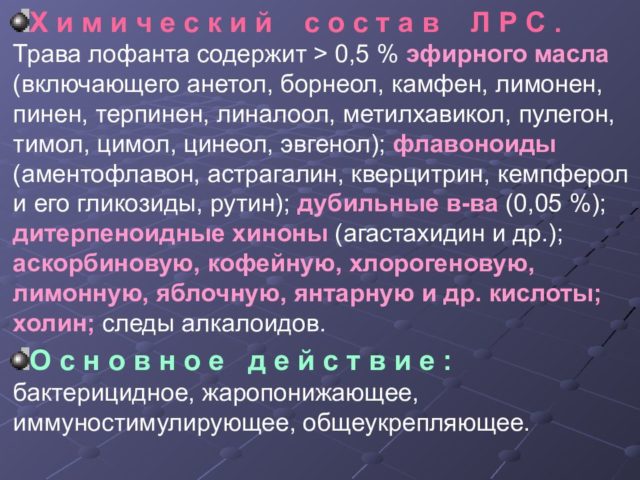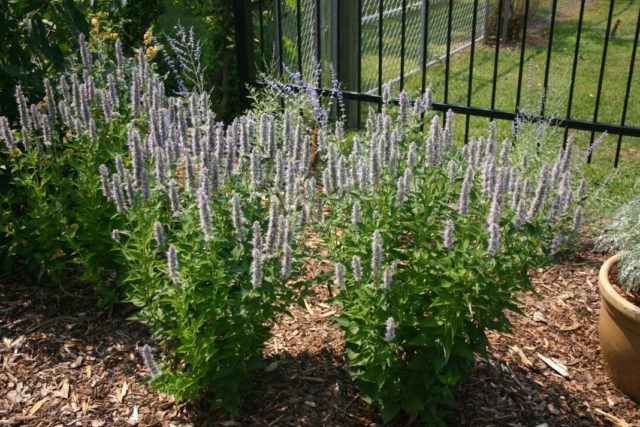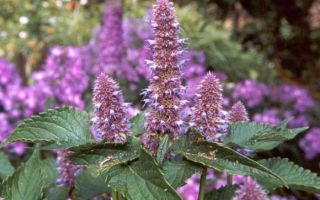Content
Useful properties and contraindications to aniseed lofant are well known to everyone who is fond of traditional medicine and cooking. This spicy-aromatic plant is not only an excellent seasoning, but also has medicinal properties. The plant contains various chemical compounds and has a certain effect on the human body.

The chemical composition of aniseed lofant
The healing properties and composition of the herb have not yet been fully studied. It is known that all parts of the plant contain the following substances:
- a large percentage of essential oils, in fresh raw materials of volatile substances there are about 2.5%, in dry - a little less, 2.2%, and in the composition of essential oils pulegon and menthone prevail;
- phenolic compounds are quercetin, oxycinnamic acids (caffeic, coumaric, chlorogenic, gallic), luteolin, umbelliferone;
- tanning components, the percentage of which reaches 9%;
- organic acids, including ascorbic, malic, citric - make up 1%.
The herb contains B-group vitamins, I (iodine), Fe (iron), Mn (manganese), Cu (copper), Cr (chromium), Zn (zinc) and Se (selenium).

Why is anise lofant useful?
Anise lofant is a decorative perennial. This means that the roots live in the ground for a long time, and the apical part, green grass shoots die off to the cold. It retains its decorative appearance almost throughout the entire warm period. The first shoots appear in early spring. Flowers candles open at the end of May. They have a beautiful purple or bluish color. Flowering continues until the first frost (October - November).
This plant is a great honey plant. Some beekeepers even plant whole fields with it. The fact is that there are always periods when the bees have nowhere to take nectar. At this time, anise lofant comes to the rescue, because in fact it blooms all season. In addition, it is used in folk medicine and helps with many diseases. For its healing properties, it received a second name - northern ginseng.
In the international classification, it is found as a fennel grate, but in Russia the previous two names are more common. It has a rich mineral and vitamin composition, can serve as an excellent source of useful chemical elements in winter to strengthen the immune system.
In official medicine, it is not used to treat patients. The raw material of the multi-grate is processed in the pharmaceutical industry to obtain many drugs sold through the pharmacy network. This was facilitated by scientific research, which showed that the plant contains a rich complex of antioxidant, antimicrobial, antimycotic compounds.
It is used in cooking as a seasoning, as it has a strong mint-anise smell and a spicy taste. With the help of a fennel grate, salads, drinks, fish and meat dishes are flavored. Its leaves, both fresh and dried, make an excellent herbal tea.For harvesting for the whole year, it is necessary to cut branches with a pruner, tie them into bunches and hang them in a well-ventilated, warm and dry place. Fold the dried raw materials into paper or cardboard packaging.

Harm of aniseed lofant
Anise lofant does not cause any harm to the human body. When used correctly, it is of great benefit.
Contraindications to anise lofant
Despite its many advantages, the plant also has a number of restrictions on its use. This is a high-risk group consisting of young children, pregnant and lactating women, as well as allergy sufferers who have a hypersensitive reaction to any food. In addition, the multicolor is contraindicated in hypotension, epilepsy, the presence of malignant tumors in the body, and a tendency to thrombophlebitis.

Rules for the use of aniseed lofant
The medicinal properties of the aniseed lofant herb are well known to mankind since ancient times. The Indians cured skin diseases, purulent wounds with this plant, and also used it for colds, disorders in the digestive system. In Europe, the polygranch initially took root as a honey plant and an ornamental plant. But soon it became the subject of close attention of folk healers. Doctors recognized it as extremely healing and began to use it in their practice.
Recipe 1 (infusion). 2 tbsp. l. steame herbs 0.4 liters of boiling water in a thermos for 3 hours. Consume half a cup three times daily, on an empty stomach.
Recipe 2 (tinctureand). Pour 200 g of grass with half a liter of vodka for a month. Strain and take 20 drops before meals three times during the day.
Recipe 3 (gel for external use). Grind 100 g of green leaves with two tablespoons of olive oil in a mortar. Apply in a thin layer.
Recipe 4 (tea for hypertensive patients). Take in equal amounts: lofant + hawthorn flowers + motherwort + white mistletoe + marsh creeper. 4 tbsp. l. collection pour a liter of boiling water overnight. Divide the resulting solution into three to four equal volumes and drink during the day. Reception should be carried out after meals, not earlier than an hour later.
Tinctures, decoctions, and many other medicinal products are prepared from the stems and leaves of the plant. The Greeks were very fond of this plant to whet the appetite. Anise lofant is surrounded by many rumors and myths. He is credited with various miraculous properties, considering it a panacea for almost all diseases. This is an exaggerated opinion, although the herb has some medicinal qualities.

Application of anise lofant
Fennel grate - this is the name of anise lofant known all over the world. Its medicinal properties have found application in folk and official medicine in many countries. The plant is also used to prepare culinary masterpieces that surprise the most fastidious gourmets with their delicate aroma.
Anise lofant in folk medicine
For medical practice, phytotherapists use the entire ground part of the plant. In addition to general strengthening properties, aniseed lofant is well known as a healer of many diseases. With the help of a plant, such problems leave the human body:
- headache;
- sleep disorders;
- disorders of the nervous system;
- high pressure;
- edema provoked by diseases of the veins of the lower extremities;
- liver pathology;
- digestive problems;
- colds;
- weakening of vision;
- hearing impairment;
- hormonal imbalance;
- inflammation of the genitourinary system.
Anise lofant normalizes metabolism, increases efficiency, relieves fatigue, neutralizes the effects of stress. Decoctions and infusions of the plant cleanse the body and internal organs of a person from toxins and toxins. Their regular intake inhibits the process of decay of body functions.
Plant preparations are used externally for the healing of burns, small wounds. The gel, made from fresh greens of the plant, even copes with fungal diseases. Due to its strong antioxidant properties, the herb is used in cosmetology, for the preparation of skin and hair care products.
Recipe 1 (anti-aging mask). Take all the ingredients in 1 tbsp. l. and mix together: chopped lofant greens + cottage cheese + honey + sour cream. Apply for ¼ hour, rinse with a decoction of the herb.
Recipe 2 (hair mask). Rub juice from green lofant into the surface of the head, moisten hair. Soak for half an hour and rinse.
Recipe 3 (mask for acne and blackheads). Dilute the healing clay with lofant infusion. Apply the gruel to the face and keep it until it dries. Wipe the skin clean with a decoction of herbs.
Recipe 4 (lotion). Mix equal amounts of lofant and chamomile infusions. Pour 1 tbsp into the solution. l. medical alcohol. Keep in the refrigerator.

Aniseed lofant in cooking
Freshly picked leaves and young shoots of aniseed lofant for Parkinson's disease, prostatitis and other health problems are added to salads, both vegetable and fruit, green cocktails and juices are prepared. The aromatic plant is often found in a wide variety of dishes:
- sauces;
- meat;
- a fish;
- okroshka;
- bakery products;
- minced meat for pies.
Multicolor flowers are used to make jams, compotes, tea and jelly. Add to various drinks, preservation to flavor the finished product.
Conclusion
Useful properties and contraindications to aniseed lofant should be well known in order to use this plant most effectively and safely for health purposes, without causing side effects. In the arsenal of traditional medicine, a rich experience of herbal treatment has been accumulated, there are many different recipes, methods of application, which have been repeatedly tested in practice and have repeatedly confirmed their worth.

